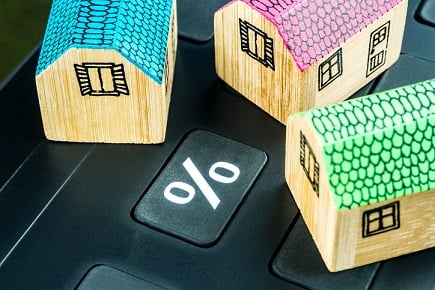Unemployment is low, interest rates are lower, consumers are spending money and the economy is great. So why is the housing market just trudging along?

Low mortgage rates may soon be heading even lower, but even that probably won’t give the housing market much of a push upward.
US homebuilding fell for a second straight month in June and permits dropped to a two-year low according to a new report from the Commerce Department, suggesting the housing market continued to struggle despite declining mortgage rates. Even though there has been a modest increase in the number of homes under construction, housing completions are a six-month low, and sluggish housing and manufacturing industries are weak spots for the economy, negating strong consumer spending.
“Residential housing construction is one of the leading indicators of a recession and while construction activity isn’t dropping precipitously, housing is stuck in a rut,” Chris Rupkey, chief economist at MUFG in New York, told Reuters. “If the Fed thinks rate cuts are going to send housing construction up like a rocket, they better think again.”
The explanation has been the same for months: low inventory for existing properties, and new construction hampered by land shortages, labor shortages, and rising building costs. On the lending side, however, rates have been decreasing since the Federal Reserve put the brakes on its plan to raise interest rates. And if the Fed makes the expected move later this month to drop interest rates even further to protect against the effects of trade negotiations with China and slowing global growth, borrowing costs could continue to fall.
The 30-year fixed mortgage rate has dropped to about 3.75% from a peak of 4.94% in November, according to data from mortgage finance agency Freddie Mac.
A recent survey showed confidence among homebuilders increased in July, although builders continued to complain that they “continue to grapple with labor shortages, a dearth of buildable lots and rising construction costs that are making it increasingly challenging to build homes at affordable price points relative to buyer incomes.”
The data
Housing starts decreased 0.9% to a seasonally adjusted annual rate of 1.253 million units in June as a rebound in the construction of single-family housing units was overshadowed by a plunge in multi-family homebuilding, the government said.
Data for May was revised slightly down to show homebuilding falling to a pace of 1.265 million units, instead of slipping to a rate of 1.269 million units as previously reported. Economists polled by Reuters had forecast housing starts dipping to a pace of 1.261 million units in June.
Single-family homebuilding, which accounts for the largest share of the housing market, increased 3.5% to a rate of 847,000 units in June, partially recouping some of May’s sharp drop. Single-family housing starts fell in the Northeast, but rose in the Midwest, West and South.
Building permits tumbled 6.1% to a rate of 1.220 million units in June, the lowest level since May 2017. Permits have been weak this year, with much of the decline concentrated in the single-family housing segment.
Permits to build single-family homes rose 0.4% to a rate of 813,000 units in June. Despite the increase last month, permits continue to lag housing starts, which suggests single-family homebuilding could remain sluggish.
Starts for the volatile multi-family housing segment dropped 9.2% to a rate of 406,000 units last month. Permits for the construction of multi-family homes plunged 16.8% to a pace of 407,000 units. Permits for buildings with five units or more were the lowest since March 2016.
Housing completions fell 4.8% to 1.161 million units last month, the lowest level since December.
Projections
The housing market has been dragging down economic growth for five straight quarters, beginning last year, and economists don’t believe that housing any impact on GDP at all in the second quarter.
The Atlanta Fed is forecasting gross domestic product rising at a 1.6% annualized rate in the April-June quarter. The economy grew at a 3.1% pace in the first quarter. The government will publish its advance GDP growth estimate for the second quarter next Friday.
The PHLX housing index .HGX was lower, underperforming in a broadly weak U.S. stock market. The dollar was little changed against a basket of currencies, while US Treasury prices rose.
Igor Cesarec, an economist at Citigroup in New York, told Reuters that those prints are in line with their view of a slow housing market, and that it is likely to continue its downward trajectory for the rest of 2019, although there are “no significant risks of an immediate slump . . .we continue to expect residential investment to be either flat or provide a slight boost to GDP growth in the second half of the year.”
Economists nationwide expect the housing market to stay stable in 2020.
Realtors estimate that housing starts and completion rates need to be in a range of 1.5 million to 1.6 million units per month to bridge the inventory gap. The stock of housing under construction increased 0.5% to 1.135 million units in June.
“A sluggish first half of 2019 indicates that builders have so far not been as willing or able to put up as many new homes as the strong economy and milder summer weather might otherwise suggest,” said Matthew Speakman, economist at online real estate group Zillow.



